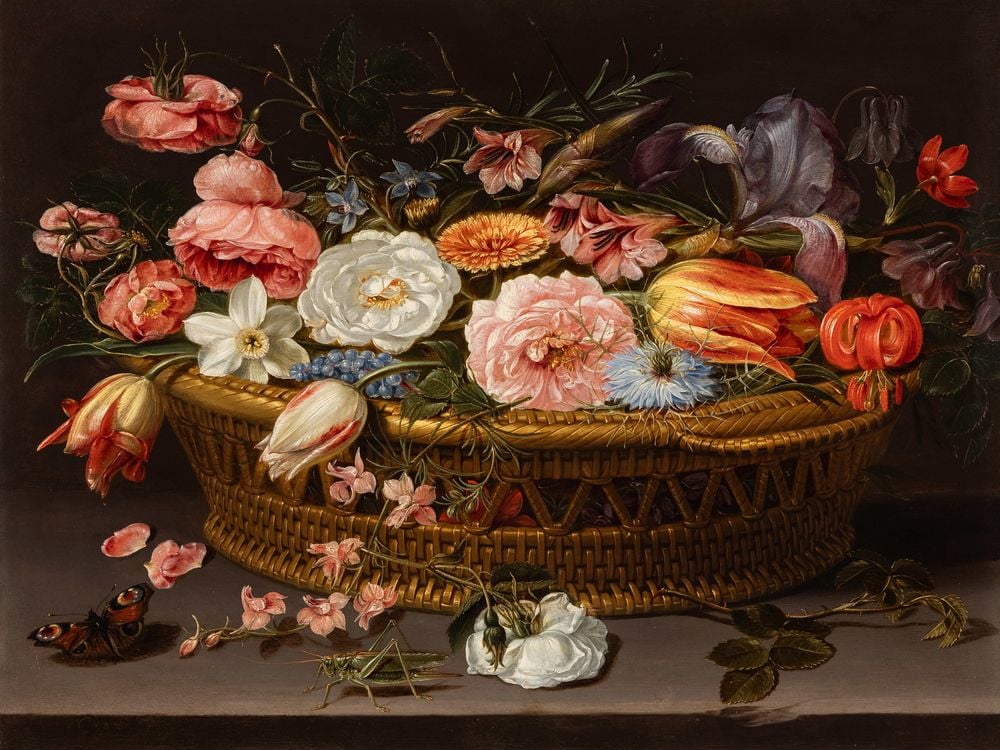
The full title of the painting by Clara Peeters is Still life of roses, carnations, tulips, narcissi, irises, love-in-a-mist, larkspur, and other flowers, in a wicker basket, with a butterfly and a cricket.
Sotheby’s
For nearly 100 years, a still life by Flemish painter Clara Peeters, a forgotten 17th-century master, hung in a private collection in Belgium. Now, the newly rediscovered artwork is heading to auction, where it could fetch between £500,000 and £700,000 (about $631,000 and $883,000).
The painting features a wicker basket full of bright pink, white and yellow flowers. Some of the flowers are wilting, and a cricket and butterfly sit among the petals collected on a ledge below.
“It’s only recently been rediscovered, so it’s never been published in the literature,” Elisabeth Lobkowicz, vice president and old master specialist at Sotheby’s New York, tells Artnet’s Brian Boucher. “It has all the hallmarks of her great works. It’s meticulous, it’s vibrant, it’s luminous, it’s captivating.”
The sale comes at a moment when museum professionals are expressing a desire to correct persistent gender imbalances in their collections, a task that’s especially challenging for periods of art history that were dominated by men. “Clara Peeters was undoubtedly a pioneer who paved the way for other female artists who specialized in the still-life genre, including Rachel Ruysch and Maria van Oosterwijck,” per a statement from Sotheby’s.
Peeters is a mysterious figure. Only about 40 of her works are known to exist, and the details of her life are hazy. She likely worked in Antwerp, as many of her pieces exhibit distinct marks from the Belgian city.
“Various attempts have been made to identify her in archives with certainty,” writes Sotheby’s. “Perhaps the most convincing suggestion is that … she was the Clara Lamberts who was born in Mechelen in 1587, married the Antwerp painter Hendrick Peeters in 1605 and later died in Ghent after 1636.”
Experts think Peeters was trained by a skilled painter, though no documentation of her artistic education exists. The Antwerp painters’ guild records reveal no information about her life or work.
Peeters’ talent, however, is evident. She was a pioneering European still-life artist known for her accurate, meticulous portrayals of nature, which include small details such as dew drops and insect bites.
Her work was highly coveted, and some of her pieces traveled long distances to join prestigious collections. For example, by 1666, two of her kitchen still lifes were documented in the Royal Collection in Madrid.
“Her paintings were quite prized objects and were being passed around,” Chloe Stead, an old masters specialist at Sotheby’s, tells the Guardian’s Harriet Sherwood. “[This] makes it so remarkable that she—like so many of her female contemporaries—were, over the centuries thereafter, written out of art history, and only rediscovered and reassessed in the mid-late 20th century.”
So far, Peeters’ most expensive work is Still Life with Pitcher and Cheese Plate, which sold in 1998 for $1.7 million—far higher than its $337,000 estimate. If the recently rediscovered painting exceeds its estimate, it could rank among the artist’s most valuable works.
Lobkowicz tells Artnet that the painting is a “very exciting” find in “impeccable condition.”
“What draws me to it the most is that it’s on a very small scale, but it has immense visual impact,” she adds. “It’s a kaleidoscope of color and detail, expertly rendered.”
Recommended Videos
